Hunting with Paper Patch Bullets in Sharps 45/120 AKA 45/110
Hunting with Paper Patch Bullets in Sharps 45/120 AKA 45/110
by Tom Ball
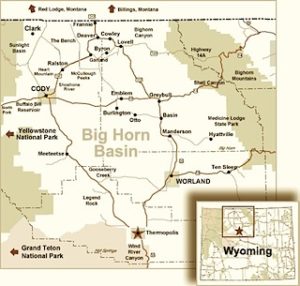 Taking Elk With a Paper Patch Bullet. My 21-year old son Eric and I drew cow elk tags as our second choice in our favorite hunt unit in the Bighorn Basin of Wyoming. My 2006 elk hunt ended with my son and me each taking a cow elk. No, he has not graduated to the Sharps yet, and prefers the old Mauser 30-06 I gave him when he was a boy. From the opener of October 1 and through that month we hunted the high country or summer range, but we only found bulls! You know how that works; you only see animals that you can’t shoot. At one point we were within 35 yards of two nice 6 point bulls. Over time a couple of winter storms blew through and I finally decided it was time to hunt the herd’s traditional winter range.
Taking Elk With a Paper Patch Bullet. My 21-year old son Eric and I drew cow elk tags as our second choice in our favorite hunt unit in the Bighorn Basin of Wyoming. My 2006 elk hunt ended with my son and me each taking a cow elk. No, he has not graduated to the Sharps yet, and prefers the old Mauser 30-06 I gave him when he was a boy. From the opener of October 1 and through that month we hunted the high country or summer range, but we only found bulls! You know how that works; you only see animals that you can’t shoot. At one point we were within 35 yards of two nice 6 point bulls. Over time a couple of winter storms blew through and I finally decided it was time to hunt the herd’s traditional winter range.
The rifle I used on this hunt is an 1874 C. Sharps 45/110, Bridgeport Model, sporting rifle with a Badger barrel [photo at right]. It seems like every time I tickle the set trigger on this rifle, something falls. I have learned to have great confidence in this weapon. With this rifle and my favorite 45/120/500 pp load, I have taken black bear, pronghorn, mule deer, elk and bison, most with just one shot. I have learned to just rely on the regular utilitarian barrel sight and the regular sliding bar on the rail in upright position for longer shots. This sight is strong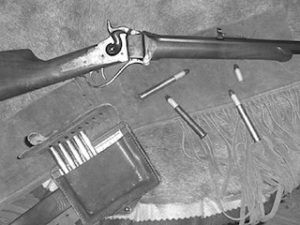 enough for tough hunting situations and the settings are repeatable for long shots. And I don’t have to take my eyes off of game to adjust the sight because the sight gives off audible clicks for each setting i.e., 3 clicks equal 300 yards and so on. I have made several shots on big game out to 300 yards with iron sights, however, after that target definition becomes a problem, i.e., it is hard to tell which part of a grey deer in grey sagebrush one is aiming at.
enough for tough hunting situations and the settings are repeatable for long shots. And I don’t have to take my eyes off of game to adjust the sight because the sight gives off audible clicks for each setting i.e., 3 clicks equal 300 yards and so on. I have made several shots on big game out to 300 yards with iron sights, however, after that target definition becomes a problem, i.e., it is hard to tell which part of a grey deer in grey sagebrush one is aiming at.
The load I used on this hunt and trust in this rifle is my favorite, a 500 gr. paper patched bullet loaded over a healthy dose of Swiss 2FG Black Powder (45/120/500). The paper patch bullet is from Montana Precision Swaging and it has a wicked cutting edge or wad cutter type shoulder, which leaves pronounced full caliber holes in paper targets and game. I have found, through experience, for the cutting edge to be effective, it has to have a 90 degree edge and the diameter at the cutting edge has to be at least .045 larger than the diameter of the bullet’s nose in front of it. Every big game animal I have shot with this load expires “very quickly” from a rapid loss of blood. Or in other words they can’t go on because their crank case has been drained. This load will always shoot through elk on broadside shots either through the ribs or through both shoulders. More about this load later.
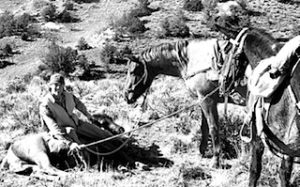 The area we wanted to hunt lay about two miles into a walk-in-hunt only area. We rode in on my saddle horse Rosie with a saddle mule named Red led by my best pack mule, Lena. Lena could pack out a Tyrannosaurus Rex if there was a season open for ’em. The previous spring had been fair for moisture so grass for elk feed had grown, but the summer was one of the driest on record. The country is made up of fairly steep foothills covered with limber pine sagebrush and grass.
The area we wanted to hunt lay about two miles into a walk-in-hunt only area. We rode in on my saddle horse Rosie with a saddle mule named Red led by my best pack mule, Lena. Lena could pack out a Tyrannosaurus Rex if there was a season open for ’em. The previous spring had been fair for moisture so grass for elk feed had grown, but the summer was one of the driest on record. The country is made up of fairly steep foothills covered with limber pine sagebrush and grass.
While riding in I told my son that elk will nearly always be here, late in the season, if there is plenty of grass for feed. That meant if there had been enough rain during the growing season to produce good grass to start with and if the area had not been overgrazed by livestock. We were very gratified that both things had occurred; plenty of grass waving in the breeze met our eyes and the rancher had done a very good job of management on this piece of country. We soon found out that the elk appreciated the grass as much or more than we did.
The first time I brought Eric to hunt this area was when he was nine years old and after a couple of hours of not as much as even seeing an elk track, he said, “Dad, where are all the elk?” I replied with the proverbial answer, “Son, elk are where you find ‘em.” Just at that moment we topped a sagebrush ridge and there across a beautiful grassy bowl was a huge herd of about 300 head of elk! We quickly recovered from our surprise before the elk spotted us and after a long crawl on our bellies, we got within 100 yards of the herd.
Nine year old Eric then witnessed for the first time an elk being shot. He still talks about that first elk hunt. My friends, that’s what life is all about! On that trip he was witness to my laying down a 5 point bull elk with a Shiloh Sharps 1874 in 45 2.1 inch caliber. The load used a 405 gr. flat nosed pure lead bullet, from a Hoch nose pour mold (photo below), from 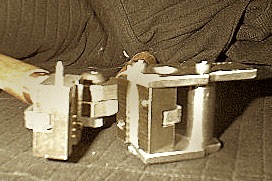 Colorado Shooters Supply, loaded over 70 grs. of 2FG Goex black powder. The bull took the broadside shot through both lungs and bled out after about a minute and tipped over.
Colorado Shooters Supply, loaded over 70 grs. of 2FG Goex black powder. The bull took the broadside shot through both lungs and bled out after about a minute and tipped over.
Here we are back again in 2006 and now both Eric and I have elk tags. When we got up on top of the first pine covered ridge, we stopped to rest the horse and mules and couldn’t help but admire all of the “beautiful grass”. While I was taking a little break, Eric walked over a few yards to peer into a little side canyon. Suddenly, he hunkered down and gave me the thumbs up sign! He was soon by my side telling me that there was a whole herd of elk feeding in the bottom of the little side canyon. There were about 45 head of elk that we could see.
We tied up our stock and quickly figured out a stalk strategy that would screen our approach while keeping the wind in our face. We chose a route down a feeder draw that would take us out of sight to the last cover, a limber pine just a little above the elk. After a stalk of about half an hour, we reached the pine tree, but we had to crawl the last fifteen yards. Before this moment we had agreed to count down from 3 to shoot if we got on more than one elk. While catching our breath, I got the range to the elk with a Bushnell 1000 Range Finder; 220 yards. The cows we wanted had fed out of the bottom onto the side of a ridge and were on the same level as we were.
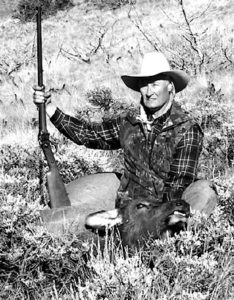 After carefully trying to decide which cows were dry etc., (no calves close by) we counted 3, 2, 1, bam! Both shots sounded as one and the whole herd disappeared in a flash except two cows that had been shot broadside through the bread basket (lungs). Both cows were dead by the time we reached them.
After carefully trying to decide which cows were dry etc., (no calves close by) we counted 3, 2, 1, bam! Both shots sounded as one and the whole herd disappeared in a flash except two cows that had been shot broadside through the bread basket (lungs). Both cows were dead by the time we reached them.
Eric used a 165 gr. Remington corlokt bullet and both of our bullets passed clear through our elk. We shook hands on a job well done, took pictures and then the fun was over and the work began. We were done and the elk loaded in about 2-1/2 hours.
I had previously wiped my rifle’s bore out with a water dampened patch followed by a couple of dry ones and finally wiped the bore with a patch soaked with Hoppes No. 9 Nitro Powder Solvent to protect the bore and displace any left over moisture. This cleaning combination has never let me down in the field. The old time buffalo hunters and Creedmoor shooters used plain old water to clean out black powder fouling from their bores and I figure what’s good enough for them is good enough for me.
It took us about two hours to walk out with all of our pack critters loaded. We got back to the truck about dark and we were cold and hungry, but virtually unscathed. However, the cattle path we took off of the mountain’s north face was covered with limber pine and we had to stop occasionally to cut branches down that challenged our passing. On one of these branch cutting stops, poor Eric was bringing up the rear and the horse packed with elk quarters spooked when a branch rubbed her face and the butt end of one of the legs on an elk quarter struck him in the face. The blow about knocked him down. I felt really bad, but it seemed to hurt his pride more than his face. But his face was sorta red for a while!
Elk hunters in our family always say there are no easy elk hunts, but all in all, Eric and I agree this was the easiest elk hunt we have ever been on. Now we have a freezer full of really good and “good for you” elk meat to help get us through the winter.
Historical Perspective on my Favorite Hunting Cartridge. I hunt with Sharps rifles because of their place in history representing the almost mythical capability of a uniquely American weapon, the Sharps long range sporting rifle. As a mere lad of ten years old, I held my first original Sharps Sporting rifle and I swear I heard hoof beats and war whoops, but that is another story. I think I can blame some of this mental condition on my ole Great Grand Dad,  who was a buffalo runner that operated on the plains of west Texas in the 1870’s. He preferred the 50/90 or 50 2.5 inch case.
who was a buffalo runner that operated on the plains of west Texas in the 1870’s. He preferred the 50/90 or 50 2.5 inch case.
My personal favorite is the 45 2-7/8 inch Sharps case or better known today as the 45/110. This cartridge, according to the great western bear hunter Col. William Pickett, was used by about half of the hunters that participated in the slaughter of the northern buffalo herd in Montana. Even though many cartridges have been referred to by their caliber and supposed powder charge like the 45/110, the Sharps factory would refer to the same cartridge by caliber and case length, thus the 45 2-7/8 inch cartridge. This type of designation avoided much confusion because powder charges could vary greatly even in the same case depending on the loading techniques, 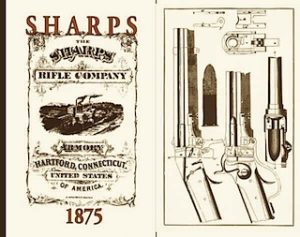 while the caliber and cartridge length stayed constant. In fact, in many places the old Sharp’s catalogs state, “the amount of powder loaded in cartridges chambered for Sharps rifles depends on the technique used in slowly pouring the powder into the case through a long loading tube.” (Catalog photo from www.cornellpubs.com)
while the caliber and cartridge length stayed constant. In fact, in many places the old Sharp’s catalogs state, “the amount of powder loaded in cartridges chambered for Sharps rifles depends on the technique used in slowly pouring the powder into the case through a long loading tube.” (Catalog photo from www.cornellpubs.com)
Nowadays when you say 45/110 most shooters know it is the 45 2-7/8 inch Sharps and not the longer 45 3.25 inch case developed after the Sharps Co. had closed its doors in 1881. The longer case was referred to at times as the 45/120 which was developed later on and used in Winchester’s High Wall Rifle. Granted there are known Sharps rifles out there chambered for the 3.25 inch case, but they are probably rechambers of shorter 45 caliber chambers after they left the factory.
Historical writings from Sharp’s rifle users confuse things even more. In the book written by Andrew Garcia entitled, A Tough Trip Through Paradise, the author refers to his Sharps Buffalo 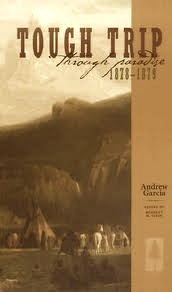 as being chambered for the 45/120 cartridge. The events in his book took place primarily in 1879. He stated that with this Sharps he dispatched a huge grizzly bear that was threatening the life of he and his Indian wife when the bear visited their camp late one night. I am convinced that his rifle was chambered for the 45 2-7/8 inch case and loaded with 120 grs. of powder. Why? Because the Sharps Co. never advertised as having any rifles produced in the 3.25 inch case, but the 45 2-7/8 inch case was a regular factory item; there are historical references that state hunters loaded 120 grs. of powder in the case and it was very popular in the West for big game hunting, especially for use in hunting buffalo.
as being chambered for the 45/120 cartridge. The events in his book took place primarily in 1879. He stated that with this Sharps he dispatched a huge grizzly bear that was threatening the life of he and his Indian wife when the bear visited their camp late one night. I am convinced that his rifle was chambered for the 45 2-7/8 inch case and loaded with 120 grs. of powder. Why? Because the Sharps Co. never advertised as having any rifles produced in the 3.25 inch case, but the 45 2-7/8 inch case was a regular factory item; there are historical references that state hunters loaded 120 grs. of powder in the case and it was very popular in the West for big game hunting, especially for use in hunting buffalo.
One reference in particular caught my interest, the one used by the old time Montana buffalo runner, Barney Colleran found on page 124 of Encyclopedia of Buffalo Hunters And Skinners. His preferred load was in a 45 2-7/8″ case and was loaded as a 45/120/500 pp load. I adopted this 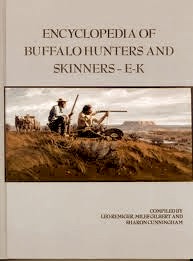 loading after testing it extensively in my C. Sharps 1874 rifle weighing 9.5 lbs. with a 28 inch Badger barrel chambered for the 45 2-7/8 inch case. The load in my rifle produces recoil that is easily managed while producing awesome power in downing big game and having a very flat trajectory. More specific data on this load later.
loading after testing it extensively in my C. Sharps 1874 rifle weighing 9.5 lbs. with a 28 inch Badger barrel chambered for the 45 2-7/8 inch case. The load in my rifle produces recoil that is easily managed while producing awesome power in downing big game and having a very flat trajectory. More specific data on this load later.
Finding An Old Time Load. I had tried the load used by some of the Texas buffalo hunters, 45/110/550 paper patch (pp), and I killed several species of big game with this load and it was deadly. However, in a rifle that a hunter can carry all day without fatigue, which to me is a maximum of ten lbs., this load shook the roots of my teeth.
After much research of the old writings on buffalo cartridges and techniques used to load them, I discovered my favorite old time load for the 45 2-7/8 inch case. That is when I read about the load used by the ole Montana Buffalo Hunter Barney Colleran alluded to above. After testing the 45/120/500 pp load and shooting several head of big game with it, I knew why many of the Montana buffalo runners of the late 1870’s and early 1880’s preferred this loading. I wanted a paper patch load like those used by most of the old time hunters before the general use of grease grooved bullets began. Why? Because I like to experience the use of historic weapons and use their original type of loads and to me gun powder is black.
Specifics on 45/120/500 pp Load. The old Sharps catalogs state that their hunting cartridges worked best when loaded with the maximum amount of powder. So I generally start out load development for my hunting loads a little different than someone who is looking for a target load. Through trial and error I try to pour in as much powder as possible through a 24 inch drop tube to fill the case within about 1/16 inch from the top. This powder level generally allows me to use either a .030 or .060 thickness Walters fiber wad depending on whichever a particular rifle likes and apply about .200 to .230 compression depending on the cartridge to leave just enough room to seat a lube wad and still barely seat the base of the bullet in the case. This means that I use a bullet when patched of just under bore diameter and the bullet is loaded way out Creedmoor style to allow more room for powder. I am usually able to get hunting 3 shot groups of at least 1.5 inches without wiping or using a blow tube.
I can only recommend the following data for my rifle because I cannot control the loading methods used by someone else. However, perhaps others can use some of the information in their own load development.
Load Data for 45/120/500 Paper Patch Load in the 45 2-7/8 inch Case.
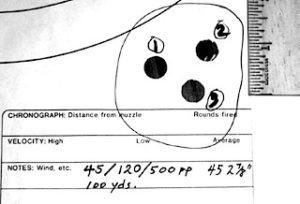 • A charge of 120 grains by weight of Swiss 2F powder is slowly poured thru 24″ drop tube into Starline 45 2.6 cases formed by Buffalo Arms into 45 2-7/8 inch cases (a small amount of testing so far has shown Swiss 1-1/2 F will work just as well). Either new or fired cases work well, but the fired cases are left unsized before loading just like in the old days. The cases are treated to a uniform primer pocket depth, the primer vents are deburred and case mouths are chamfered, then the cases are primed with Federal Magnum. BR LR primers. This load produced an average of 1465 fps velocity 10 ft. from the muzzle on my Chrony Alpha chronograph in a 28 inch barrel. Update Note: Five more grs. of powder gives an average velocity of 1500 fps and accuracy did not suffer in my rifle. Preliminary tests indicate this little extra charge seems to make this load shoot a little flatter over 300 yards than the 40/90 SBN which I am currently experimenting with, but again that’s another story.
• A charge of 120 grains by weight of Swiss 2F powder is slowly poured thru 24″ drop tube into Starline 45 2.6 cases formed by Buffalo Arms into 45 2-7/8 inch cases (a small amount of testing so far has shown Swiss 1-1/2 F will work just as well). Either new or fired cases work well, but the fired cases are left unsized before loading just like in the old days. The cases are treated to a uniform primer pocket depth, the primer vents are deburred and case mouths are chamfered, then the cases are primed with Federal Magnum. BR LR primers. This load produced an average of 1465 fps velocity 10 ft. from the muzzle on my Chrony Alpha chronograph in a 28 inch barrel. Update Note: Five more grs. of powder gives an average velocity of 1500 fps and accuracy did not suffer in my rifle. Preliminary tests indicate this little extra charge seems to make this load shoot a little flatter over 300 yards than the 40/90 SBN which I am currently experimenting with, but again that’s another story.
• Use compression die to apply between .200 to .235 compression depending on the brass, enough to allow barely enough room for case to hold powder charge, a .060 Walter’s veg. wad and a 1/8″ grease cookie of any good black powder lube. Right now I am using Shiloh’s DGL lube because it seems to be very stable under extreme temperature changes found hunting while still being an excellent lube.
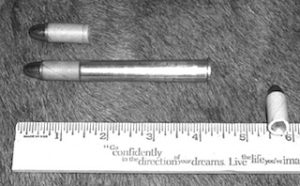 • .440 unpatched diameter 500 gr. straight sided bullet bullet (40:1 alloy) from Montana Precision Swaging, patched with a water moistened 100% cotton 9lb. paper with two wraps. When wrapped, this brings the patched diam. up to .447 to .448 or just under the .450 bore diam. and allows Creedmoor type loading of the bullet way up into the rifling to allow more powder space, just like in the old days. My tests seem to work best with a hollow base bullet and a patch that is just wide enough to fold over the base (no tail). Rooster Red liquid bullet and patch lube is finger applied to the dried patch. This step alone usually cuts group size by half.
• .440 unpatched diameter 500 gr. straight sided bullet bullet (40:1 alloy) from Montana Precision Swaging, patched with a water moistened 100% cotton 9lb. paper with two wraps. When wrapped, this brings the patched diam. up to .447 to .448 or just under the .450 bore diam. and allows Creedmoor type loading of the bullet way up into the rifling to allow more powder space, just like in the old days. My tests seem to work best with a hollow base bullet and a patch that is just wide enough to fold over the base (no tail). Rooster Red liquid bullet and patch lube is finger applied to the dried patch. This step alone usually cuts group size by half.
• The bullet is finger seated taking care not to tear the patch on the case mouth and just barely fits into the case enough so that a “slight” crimp can be applied (just enough to hold the bullet in the case) from a regular 45/70 Lyman type crimp die (not a taper crimp). These loads are fairly tough for field use and the Rooster Red seems to make the patch some what resistant to moisture and abrasion. The slight crimp will be removed before the bullet even moves because the charge of BP upon explosion obdurate the bullet removing the crimp.
Other Hunting Loads in the 45 2-7/8 inch Case:
• Two loads that show real promise are duplications of old time express loads in the 45 2-7/8″ case for deer antelope and black bear etc. are listed below. These loads were found in Colonel Pickett’s writings. He was the famous grizzly bear hunter of the 1870’s — 1890’s in Wyoming and Montana. His loads used either a 350 grain paper patched bullet or the old Gould type 330 grain hollow point grease groove bullet.
• 45/120/380 (straight sided Mont. Prec. .440 diam. Bullet). I use 120 grs. by weight of either Swiss 2F or 1.5F dropped thru a 24″ tube shoots into 1-1/2″ at 100 yds. Again, I use 1/8″ compression and a 1/8″ lube cookie over a .060 veg. wad. This load chronographs about 1675 fps in a 30″ bl. and 10 ft. from the muzzle.
• One other load that I am working on uses the old Gould hollow point bullet with 110 grains by weight of Swiss 2F and 1.5F powder. Again, I pour the powder thru the 24″ tube, but with only light compression along with a .060 veg. wad. The bullet is seated so that all grease grooves are covered. This load only shoots into a 2.5″ 4 shot group so far, but that is without any wiping between shots. I’m not done with it yet. It chronographs at about 1700 fps from a 28″ bl.
 Steve Brooks of Tru-Bore Bullet Moulds built me an excellent mould of my design which produces a 500 grain .460 diameter bullet with a cutting edge on it. I am getting about 2.5 inch groups at 100 yards with 100 grs. of Swiss 1.5FG powder. This is good accuracy, but I want to try 105 grs. for more velocity and experiment (play with seating depths, etc.) until I get the groups down around 1.5 inches. I size this bullet to .458 to remove any air pockets. The alloy is 20:1, but I may even try some water quenched tire weights for harder bullets because cutting edge bullets do not have to expand to kill humanely.
Steve Brooks of Tru-Bore Bullet Moulds built me an excellent mould of my design which produces a 500 grain .460 diameter bullet with a cutting edge on it. I am getting about 2.5 inch groups at 100 yards with 100 grs. of Swiss 1.5FG powder. This is good accuracy, but I want to try 105 grs. for more velocity and experiment (play with seating depths, etc.) until I get the groups down around 1.5 inches. I size this bullet to .458 to remove any air pockets. The alloy is 20:1, but I may even try some water quenched tire weights for harder bullets because cutting edge bullets do not have to expand to kill humanely.
 A Modern Creedmoor Load for the 45 2-7/8 inch Shell. I am more of a hunter than a target shooter, even though I generally produce about 50 targets when working up loads in a new rifle. Sorry, I believe if you can’t hit a paper bulls-eye when braced up on a bench rest, you sure as heck can’t hit a deer’s vital area when sitting on your butt and resting your elbows on your knees!
A Modern Creedmoor Load for the 45 2-7/8 inch Shell. I am more of a hunter than a target shooter, even though I generally produce about 50 targets when working up loads in a new rifle. Sorry, I believe if you can’t hit a paper bulls-eye when braced up on a bench rest, you sure as heck can’t hit a deer’s vital area when sitting on your butt and resting your elbows on your knees!
This case has enough powder that there is a 1,000 yard load I would like to try in a heavy rifle of at least 13lbs., and a barrel length of 34 inches, like the Quigley, but would like it to have a pistol grip like Shiloh’s Long Range Express.
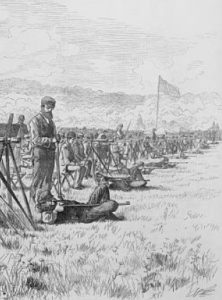 The following load, I think, would be awesome and would be a real wind bucker. I would start out by loading the case just like my 45/120/500 pp load, but I would substitute a Montana Precision tapered 550gr. pp bullet for the 500 gr. bullet. This bullet is .440 at its base and I would patch it with 16 lb. bond paper treated with Rooster Red Liquid Patch Lube without a grease cookie because I would wipe the bore after every shot just like the old Creedmoor matches. The patched bullet diameter measures out just about bore diameter, but it fits nicely.
The following load, I think, would be awesome and would be a real wind bucker. I would start out by loading the case just like my 45/120/500 pp load, but I would substitute a Montana Precision tapered 550gr. pp bullet for the 500 gr. bullet. This bullet is .440 at its base and I would patch it with 16 lb. bond paper treated with Rooster Red Liquid Patch Lube without a grease cookie because I would wipe the bore after every shot just like the old Creedmoor matches. The patched bullet diameter measures out just about bore diameter, but it fits nicely.
I get fine accuracy with a target load using this same patched bullet in my Sharps 45 2.4 inch rifle.~
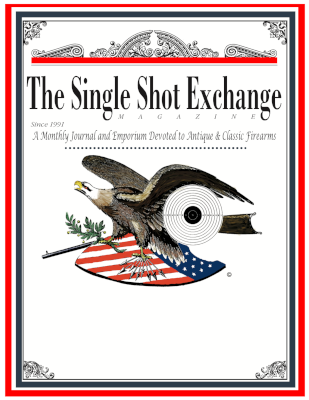



Mike Browning
Very good article.
Dana Finlayson
Very good article. I have a Farmingdale Sharps rifle in 45 3 1/4, give to me as a gift from my Son, He purchased this rifle from a fellow in Louisiana. I have done extensive research on this cartridge, After slugging this rifle it has a 451 bore and a 455 groove diameter, 1-20 twist, and 30 barrel. roughly .250 free bore, and thinking of a.460 over bore. case overall length is 4.455 which is just into the lands. some what confused. of the bullet diameter, as i:ve read that the Farmingdale rifles were chambered for paper patch bullet. i want to use this rifle for hunting as it weights 10 lbs. Would like to make contact with Tom Ball